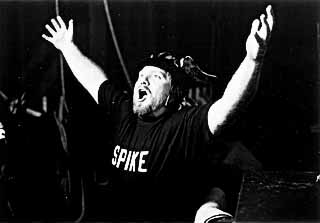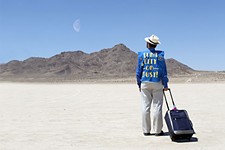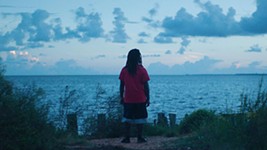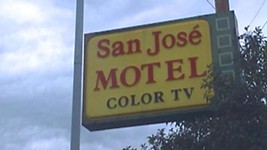A Night at the Opera
Jon Else's 'Sing Faster' Presents Wagner's 'Ring Cycle' Like We've Never Seen It -- From the Stagehands' Perspective
By Anne S. Lewis, Fri., Oct. 6, 2000

Sure, opera's an acquired taste; many find it hard to sit through -- much less love. After watching Jon Else's truly hilarious, Emmy- and Sundance-awarded Sing Faster: The Stagehands' Ring Cycle -- Wagner's opera from the stagehands' perspective -- even those who think a Ring Cycle is one of the choices on a washing-machine dial might be inclined to give opera a chance (if only just to experience this one as it's meant to be seen -- from a seat in the audience). That's what happened to the filmmaker himself, who admits he wasn't an opera fan before he made the film.
Sing Faster, showing this Wednesday, October 11, as part of the Texas Documentary Tour, compresses Wagner's 17-hour epic into a 55-minute documentary, bringing us along for the rehearsals that start a month before opening night at the San Francisco Opera. We're privy to all the behind-the-scenes work -- the setting up and dismantling of enormous, heavy sets like the hydraulic dragon (which must be executed with train-switch precision), maintaining control of special effects like the overzealous fog machine, and the seemingly impossible task of coordinating all of it, out of the audience's earshot, in hushed tones over headsets.
We watch the stagehands killing time while waiting for their next cues, sitting around in their Barcaloungers, playing poker, learning how to needlepoint, watching a TV ball game, joking about the opera, gunning for dates with Rhinemaidens and ballerinas. The voiceover is provided by one of the principal stagehands, Ken "Spike" Kirkland, inarticulately trying to explain the plot of labyrinthine, 19th-century Wagner. And, in the background, there's always the shrieking opera.
Else says the opera company was incredibly cooperative, allowing them complete access; they even rigged cameras inside the dragon and pieces of scenery. Originally, the crew was only allowed to film during rehearsals, but then they were allowed to film during dress rehearsals, and even during some performances. In fact, Else spent one performance of the fourth opera (a five-and-a-half-hour one) hanging off a little ladder right above the stage.
What Else has done here so well is to render populist an art form and a story which have been appropriated by, if not originally intended for, the well-born. Cutting back and forth between what's going on in front of and behind the curtain, he shows us the artifice of it all, the contrast between the rarified atmosphere of Wagner's plot and medium and the practical, latter-day machinations required to produce it. Of course, as seen through the eyes of the union workers who are there because they've got a job to do, much gets lost in the translation. Though, as we glean from Kirkland's voiceover explication, those universal themes of love, greed, power, and redemption are called universal for good reason. Then, at the end, on opening night, the opera house doors are flung open, and we see excited, ticket-holding fans literally bursting through the doors and sprinting, not walking, to their seats. The point being that even today -- for some -- opera's 19th-century magic remains undiminished.
Else's other documentary work includes The Day After Trinity: J. Robert Oppenheimer and the Atomic Bomb (1980) and Yosemite: The Fate of Heaven (1989). He was a producer and cinematographer for Henry Hampton's Eyes On the Prize: America's Civil Rights Years (1987). A MacArthur Fellow from 1988-93, Else now teaches at Berkeley and Stanford.
"I spent most of the past 20 years making very complicated, deadly serious films about nuclear war, civil unrest, environmental collapse, economic depression, and the like, but had always wanted to do a musical. Wagner's Ring Cycle may not seem like a good candidate, but that is what the San Francisco Opera was doing at the time," Else explains.
Austin Chronicle: Well, of course, I've got to ask you how you did those two amazing time-lapse sequences, especially the one at the end where you compress the 17-hour Ring Cycle into about one minute.
Jon Else: There are two big time-lapse sequences in the film. One at the beginning, which shows all of the construction of the sets and all the arranging and moving of the sets. And one at the end where we take all 17 hours of the Ring Cycle and condense it to about 60 seconds. They were fairly carefully planned well before we started shooting. What we did was bolt an Arriflex camera with an intervalometer to the railing of the second balcony of the San Francisco Opera. It took one frame every 20 seconds for about two months. And we took that footage and edited it to those two sequences. The gag with the time lapse at the end is that throughout the entire hour of the film, you've never been allowed to watch the opera from the auditorium, from the house. So at the end you finally get to watch the whole thing from beginning to end -- every single scene.
AC: The film has such an affectionate tone to it that one assumes that the filmmaker must surely be an opera fan.
JE: No, I had not been an opera fan at all. My wife and I had taken our kids to see La Traviata. It was a family matinee, and they left the curtain open during one of the scene changes. It was great. The soprano finished her aria and left the stage. Then all of a sudden 100 workers came out and transformed a palace into a cornfield or a cornfield into a palace -- I can't remember what it was. I approached the San Francisco Opera to see if we could do a little behind-the-scenes movie about the scene changes, and they said sure. And then we both forgot about it. Then about six months later, they called me back and said, "We're doing the Ring Cycle, do you want to do the Ring Cycle?" And I, without thinking, said sure, never having heard the Ring Cycle. I went out and got a recording of it and sat down and listened to it. I thought, "Are they kidding? People actually listen to this shit? I can't imagine people actually paying money to listen to this garbage." And then slowly it began to grow on me. It is certainly an acquired taste. By the time we finished shooting, I was a complete maniac for the Ring Cycle.
AC: What was it about the stagehands' perspective that attracted you?
JE: Well, I've always been really interested in working people; I've done a lot of work. I've worked in factories, and I've worked in construction. I'm just fascinated by the work that people do. Old-fashioned work. The thing that attracted me originally was the grandeur of the sets. Then I began to hang out with the guys who did this astonishing work. Two things struck me. One, just the amazing skill and intricacy involved. They're almost like musicians the way they move, the way they choreograph, the way they can have several huge sets moving on the stage at the same time -- all in silence. The second was how well they knew the operas. I don't know why that should have surprised me, but it did.
AC: This was obviously a fairly challenging project. What would you say was the biggest challenge of the shoot?
JE: Hardest part of the shoot was doing clean sound recording in the backstage environment where everyone is whispering and a 106-piece orchestra is blasting away. The interlacing of all the intercom recordings with the music and production recordings was really tricky.
AC: Sing Faster was a funding nightmare for you. I understand it took you 10 years to complete the film just because of that.
JE: I could have finished the film in six months if anyone had been willing to put up the completion money. In the end, it took 137 funding proposals over nine years. I started it while I was on the MacArthur fellowship. Then, to give you an idea of the obstacles we ran into: Back in 1990, when I shot the film, there happened to be a TV set in the background of one of the shots, and on the TV were four very blurry, random seconds of Marge and Homer Simpson. Nine years later, when we were finishing the film in '99, Fox Television, which by then owned The Simpsons, demanded that we pay $10,000 for the right to keep that four seconds in the background. I took Marge and Homer out of the film.
When the film was completed, PBS refused to put the film in their prime-time schedule. They didn't care for it, and don't much like it. It was sent out on a soft feed as part of "Independent Lens" and showed up at different times in different places around the country, usually at midnight or two in the afternoon. It has still not been broadcast nationwide in prime time, despite winning the Emmy this year. ![]()
Sing Faster will be presented as part of the Texas Documentary Tour on Wednesday, October 11, 7:30pm & 9:30pm, at the Alamo Drafthouse, 409 Colorado. Filmmaker Jon Else will introduce the film and conduct a Q&A session following the screening. Advance tickets are available for Austin Film Society members only by calling 322-0145. Tickets will go on sale at 6:15pm, on the day of the show. Admission prices are $6 per show for the general public; $4 for Austin Film Society and KLRU members and students.The Texas Documentary Tour is a co-presentation of the Austin Film Society, the University of Texas RTF Dept., The Austin Chronicle, KLRU-TV, and SXSW Film.










